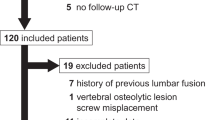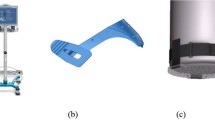Abstract
Purpose
This study aimed to propose a technique to quantify dynamic hip screw (DHS®) migration on serial anteroposterior (AP) radiographs by accounting for femoral rotation and flexion.
Methods
Femoral rotation and flexion were estimated using radiographic projections of the DHS® plate thickness and length, respectively. The method accuracy was evaluated using a synthetic femur fixed with a DHS® and positioned at pre-defined rotation and flexion settings. Standardised measurements of DHS® migration were trigonometrically adjusted for femoral rotation and flexion, and compared with unadjusted estimates in 34 patients.
Results
The mean difference between the estimated and true femoral rotation and flexion values was 1.3° (95 % CI 0.9–1.7°) and −3.0° (95 % CI – 4.2° to −1.9°), respectively. Adjusted measurements of DHS® migration were significantly larger than unadjusted measurements (p = 0.045).
Conclusion
The presented method allows quantification of DHS® migration with adequate bias correction due to femoral rotation and flexion.




Similar content being viewed by others
References
Reginster JY, Gillet P, Gosset C (2001) Secular increase in the incidence of hip fractures in Belgium between 1984 and 1996: need for a concerted public health strategy. Bull World Health Organ 79:942–946
Sanders KM, Nicholson GC, Ugoni AM, Pasco JA, Seeman E, Kotowicz MA (1999) Health burden of hip and other fractures in Australia beyond 2000. Projections based on the Geelong Osteoporosis Study. Med J Aust 170:467–470
Ho M, Garau G, Walley G, Oliva F, Panni AS, Longo UG et al (2009) Minimally invasive dynamic hip screw for fixation of hip fractures. Int Orthop 33:555–560. doi:10.1007/s00264-008-0565-4
Barrios C, Brostrom LA, Stark A, Walheim G (1993) Healing complications after internal fixation of trochanteric hip fractures: the prognostic value of osteoporosis. J Orthop Trauma 7:438–442
Ahrengart L, Tornkvist H, Fornander P, Thorngren KG, Pasanen L, Wahlstrom P et al. (2002) A randomized study of the compression hip screw and Gamma nail in 426 fractures. Clin Orthop Relat Res 401:209–222
Brammar TJ, Kendrew J, Khan RJ, Parker MJ (2005) Reverse obliquity and transverse fractures of the trochanteric region of the femur; a review of 101 cases. Injury 36:851–857
Hohendorff B, Meyer P, Menezes D, Meier L, Elke R (2005) [Treatment results and complications after PFN osteosynthesis]. Unfallchirurg 108:938, 940, 941–946
Liu M, Yang Z, Pei F, Huang F, Chen S, Xiang Z (2010) A meta-analysis of the Gamma nail and dynamic hip screw in treating peritrochanteric fractures. Int Orthop 34:323–328. doi:10.1007/s00264-009-0783-4
Saarenpaa I, Heikkinen T, Jalovaara P (2007) Treatment of subtrochanteric fractures. A comparison of the Gamma nail and the dynamic hip screw: short-term outcome in 58 patients. Int Orthop 31:65–70
Andruszkow H, Frink M, Fromke C, Matityahu A, Zeckey C, Mommsen P et al (2012) Tip apex distance, hip screw placement, and neck shaft angle as potential risk factors for cut-out failure of hip screws after surgical treatment of intertrochanteric fractures. Int Orthop 36(11):2347–2354. doi:10.1007/s00264-012-1636-0
Davis TR, Sher JL, Horsman A, Simpson M, Porter BB, Checketts RG (1990) Intertrochanteric femoral fractures. Mechanical failure after internal fixation. J Bone Joint Surg Br 72:26–31
Hsueh KK, Fang CK, Chen CM, Su YP, Wu HF, Chiu FY (2010) Risk factors in cutout of sliding hip screw in intertrochanteric fractures: an evaluation of 937 patients. Int Orthop 34:1273–1276. doi:10.1007/s00264-009-0866-2
Lee YS, Huang HL, Lo TY, Huang CR (2007) Dynamic hip screw in the treatment of intertrochanteric fractures: a comparison of two fixation methods. Int Orthop 31:683–688
Saarenpaa I, Heikkinen T, Ristiniemi J, Hyvonen P, Leppilahti J, Jalovaara P (2009) Functional comparison of the dynamic hip screw and the Gamma locking nail in trochanteric hip fractures: a matched-pair study of 268 patients. Int Orthop 33:255–260
Sheng WC, Li JZ, Chen SH, Zhong SZ (2009) A new technique for lag screw placement in the dynamic hip screw fixation of intertrochanteric fractures: decreasing radiation time dramatically. Int Orthop 33:537–542. doi:10.1007/s00264-008-0517-z
Kumar AJ, Parmar VN, Kolpattil S, Humad S, Williams SC, Harper WM (2007) Significance of hip rotation on measurement of ‘tip apex distance’ during fixation of extracapsular proximal femoral fractures. Injury 38:792–796
Lin LI (1989) A concordance correlation coefficient to evaluate reproducibility. Biometrics 45:255–268
Wilson JD, Eardley W, Odak S, Jennings A (2011) To what degree is digital imaging reliable? Validation of femoral neck shaft angle measurement in the era of picture archiving and communication systems. Br J Radiol 84:375–379. doi:10.1259/bjr/29690721
Davids JR, Marshall AD, Blocker ER, Frick SL, Blackhurst DW, Skewes E (2003) Femoral anteversion in children with cerebral palsy. Assessment with two and three-dimensional computed tomography scans. J Bone Joint Surg Am 85-A:481–488
Gardner MJ, Bhandari M, Lawrence BD, Helfet DL, Lorich DG (2005) Treatment of intertrochanteric hip fractures with the AO trochanteric fixation nail. Orthopedics 28:117–122
Gardner MJ, Briggs SM, Kopjar B, Helfet DL, Lorich DG (2007) Radiographic outcomes of intertrochanteric hip fractures treated with the trochanteric fixation nail. Injury 38:1189–1196
Watanabe Y, Minami G, Takeshita H, Fujii T, Takai S, Hirasawa Y (2002) Migration of the lag screw within the femoral head: a comparison of the intramedullary hip screw and the Gamma Asia-Pacific nail. J Orthop Trauma 16:104–107
Raudaschl P, Fritscher K, Roth T, Kammerlander C, Schubert R (2010) Analysis of the micro-migration of sliding hip screws by using point-based registration. Int J Comput Assist Radiol Surg 5:455–460. doi:10.1007/s11548-010-0498-4
Parker MJ, Handoll HH (2010) Gamma and other cephalocondylic intramedullary nails versus extramedullary implants for extracapsular hip fractures in adults. Cochrane Database Syst Rev 9:CD000093. doi: 10.1002/14651858
Acknowledgments
We wish to thank Alexander Brunner, MD for providing cases which were used in the clinical evaluation part of this study.
Conflict of Interest
The authors declare that they have no conflict of interest.
Author information
Authors and Affiliations
Corresponding author
Additional information
Laurent Audigé and Flurin Cagienard equally contributed to this work and share first authorship.
Appendix : Detailed presentation of formulae to estimate femoral rotation angle
Appendix : Detailed presentation of formulae to estimate femoral rotation angle
The relationship between the projected thickness of the DHS® plate (Tproj) and the femoral rotation angle (α) is described by two sets of formulae (Fig. 5):
Representation of DHS® plate projection (Tproj) with and without rotation. Abbreviations: T = true plate thickness (T1 = 7.23 mm, T2 = 5.8 mm); W = true plate width = 19 mm; C = radius of plate curvature (30.8 mm); α = rotation angle (defined as 90 –α1 – α2); φ = threshold rotation angle, i.e., the value of rotation above which the DHS® plate curvature influences the relationship between Tproj and α. T3 and W3 define the thickness and width, respectively, of a fictive plate defined according to the rotation angle α
Above a femoral rotation threshold angle of 18°, the DHS® plate curvature radius (C) does not influence the relationship between Tproj and α. Femoral rotation is then calculated as follows (Fig. 5b) :
For rotation angles ranging from 0 to 18°, the projection of the plate curvature must be considered. The formula presented above can be applied on a “fictive plate” defined by its width, W3 and thickness, T3 in relation to the rotation angle as follows (Fig. 5c):
Rights and permissions
About this article
Cite this article
Audigé, L., Cagienard, F., Sprecher, C.M. et al. Radiographic quantification of dynamic hip screw migration. International Orthopaedics (SICOT) 38, 839–845 (2014). https://doi.org/10.1007/s00264-013-2146-4
Received:
Accepted:
Published:
Issue Date:
DOI: https://doi.org/10.1007/s00264-013-2146-4





